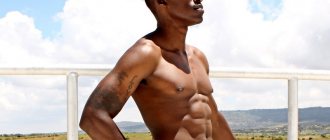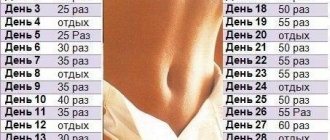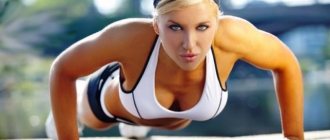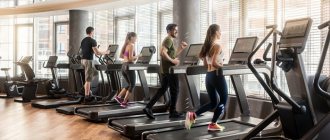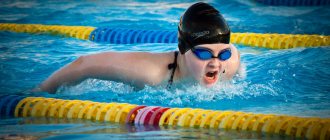Group fitness is a type of fitness for those who enjoy being in the company of like-minded people.
Group fitness classes are in many ways more interesting and more effective than individual (single) training. When studying in a group, a person involuntarily pays attention to the results of others, compares their achievements with his own, trying to improve his level.
Training programs
All group programs in the fitness club specialize in certain types of load and, depending on this, can be focused on:
- muscle strength training – muscle building;
- weight loss, burning fat deposits;
- development of functional qualities;
- development of body plasticity.
All group fitness programs can be presented in the following areas:
- aerobic exercise;
- power training;
- combined training;
- dance programs;
- children's training;
- low impact training.
Important: Choose loads that correspond to your level of training and your capabilities.
The benefits of group programs
Group fitness is one of the most popular sports training in fitness clubs. During its existence, it was able to gain millions of adherents and fans, and not only among women, because recently group fitness has begun to win the hearts of many men. In general, there is nothing surprising in the widespread popularity of group fitness classes, since they provide an opportunity to improve the functioning of the heart and lungs, improve immunity and mood, and make you strong, slim and beautiful!
By doing fitness in a group, you can easily free yourself from routine life, at least for the duration of your training, forget about existing problems and succumb to a wave of positive emotions!
One of the undoubted and obvious advantages of group training is, of course, the presence of team spirit and increased control over the execution of exercises. But this is not the only advantage of fitness classes. These include the presence of a variety of programs and techniques that can suit almost everyone, depending on their preferences, views and, of course, physical fitness.
In addition, group fitness classes provide excellent motivation for personal improvement and development. If a person performs exercises in a group that matches his physical development, he will strive, despite fatigue, laziness and other factors, to keep up with the others, to be the best and show enviable results.
Moreover, there may even be a desire to surpass others, which is undoubtedly a positive factor influencing not only physical, but also spiritual development.
Another obvious PRO of working out in a group is the opportunity to interact with other people. Thanks to this, a person can make new friends and acquaintances, expand his circle of friends and interests, exchange experiences and acquire new knowledge.
By doing sports in a group, you can find original people who will make your life more interesting. And besides, this is again a real way to overcome routine and introduce innovations into your life. Nowadays, a huge number of types of group fitness are practiced in the world, each of which, along with its positive properties, also has some disadvantages. Therefore, before making a preference, try to find out as much as possible about the direction. This will allow you to get the most positive result in many aspects, ranging from strengthening your own health, improving your figure, making new acquaintances, and ending with the usual banal opportunity to save money.
Several general areas can be distinguished: aerobic exercises, strength training, mixed format, dance, Body & Mind. To choose the right type of activity, you first need to consult a doctor about possible contraindications, then just try to attend different classes and see what you like best.
Aerobics.
To understand the types of aerobics, we can highlight the following areas:
1. Classic aerobics , sometimes also called Low . Combinations of steps with choreographic elements are performed without the use of additional equipment.
2. Step . This is aerobics on a step platform. The lesson is very dynamic, using different types of steps, each of which has its own name. When working with a step platform, it is important to follow the execution technique: the knees must be slightly bent at all times, otherwise the load on the knee joint increases. If you come to step aerobics for the first time, then first attend a basic class where you practice the basic steps. At advanced levels (step 2,3), the movements are performed at a fast pace using complex choreography, so that a beginner can get injured. But step is one of the most exciting activities.
3. Cycle . It is carried out in a class equipped with special exercise bikes, on which the position of the handlebars, saddle and resistance level are set. The class usually lasts 45 minutes, during which the pace of pedaling, resistance and body position vary. There are several cycling levels for different levels of fitness: basic, C2, C3, interval. The main indicator is the pulse, which is measured several times during the lesson.
4. Tai-bo . A very dynamic and complex lesson, using elements of Thai boxing. Good for training endurance and coordination.
Strength training.
1. Body sculpt . This activity is aimed at the harmonious development of muscle mass and burning excess fat. Exercises are performed on all muscle groups, using various equipment: body bars and light dumbbells, rubber shock absorbers. The lesson takes place at a fairly fast pace, without pauses between exercises. For beginners, it is better to take equipment of minimal weight and carefully monitor the execution technique that the trainer shows.
2. Upper body and Lower Body . Classes to develop and strengthen the muscles of the upper shoulder girdle and lower body, respectively. The same equipment is used as in classes for all muscle groups.
3. Pump . Aimed at working all muscle groups and forming a beautiful relief. Exercises are performed at a slow pace, using heavy weights. Correct technique is especially important here.
4. FT - functional training. All exercises are performed primarily with your own weight, with less or no equipment used. This is one of the most effective types of exercise.
Combined directions.
Step & Sculpt , or interval training. There is an alternation of strength exercises and combinations on the steppe. The pulse remains high throughout the entire session. Recommended for those who want to quickly lose weight.
Dance directions . This is aerobics with elements of different dance styles: Latin, oriental dance, strip dance, hip-hop. The most important thing is not so much to repeat all the steps exactly, but to get aerobic exercise, learn to control your body and enjoy the movement.
Body & Mind.
Classes aimed not only at improving the body, but also at harmonizing the internal state. This is yoga, Pilates, fitball. These lessons are recommended for people with diseases of the spine and joints, as well as expectant mothers.
Group classes in gymnastics classes are aimed at general health improvement and strengthening of the body. As a result of training, the functioning of internal organs improves, the stability of the nervous system increases, and the flexibility of the body increases.
The key to success is regularity; it is better to go to classes at a fitness club at least 3-4 times a week. A large number of different directions will make your training varied and exciting. Exercise and be healthy!
Aerobic training
They are endurance exercises that require high levels of oxygen consumption. A high level of physical activity helps stimulate all systems associated with the consumption and movement of oxygen in the body.
Regular aerobic training increases the body's endurance, normalizes blood pressure, and strengthens the cardiovascular system.
A significant advantage of this type of exercise is its strong fat-burning effect, which allows you to quickly lose excess weight.
Step aerobics
It is a set of exercises, the main element of which is the step, and the tool is the step platform. Exercises include steps, dance and strength elements. Ideal for those who decide to strengthen their legs.
Depending on the combination of actions, there are:
- Double step – the lesson is conducted using two step platforms. The undoubted advantage of this aerobics is its focus on developing coordination.
- Step interval – involves the use of dumbbells and other weights. It is considered the most effective set of exercises, requiring initial physical training.
- Step dance is a synthesis of dancing and step aerobics.
This type of group fitness class is accompanied by music. There are approximately two hundred exercises with varying levels of intensity. Heavy loads alternate with lighter ones. What makes this type of exercise popular is the simplicity of the exercises and their high effectiveness.
Types of training
Aerobic
This direction develops the body’s ability to absorb oxygen as much as possible. During the classes, the cardio-respiratory system is activated, tissue metabolism is enhanced, calories are burned, weight is lost and the figure is sculpted. Aerobic group fitness training differs in the way the programs are structured and the ultimate goals.
- Dance (dance aerobics). This is a set of exercises for large muscle groups, mainly the lower body. This type includes belly dancing (belly dancing), Latin, rock and roll, funk, strip dancing, city jam, jazz aerobics, etc.
- Step. Step aerobics is a cardio program with the main load on the leg and gluteal muscles. The training takes place to rhythmic music, on a height-adjustable platform step (the higher, the more difficult). Recommended for developing joints, increasing endurance, preventing diseases associated with physical inactivity, and improving the functioning of the vestibular apparatus. Main varieties: Step-basics (basic skills), Step-1 (medium level of difficulty), Step-comb (combination with dancing), Step interval (using weights), Double step (classes on 2 step platforms).
- Fitball aerobics. Exercises with a large Swiss ball (fitball) involve a large range of motion and require constant muscle tension. The peculiarity of the training is the absence of excessive stress on the legs. It can be used for varicose veins, joint problems and excess weight (after consultation with a doctor).
- Cyclic aerobics. Includes programs that use cyclic activities (cycling, rowing, running). Trainings take place to music, on machines that force all parts of the body to work.
Power
Strength types of group fitness training are designed to build muscle mass and “build” relief. The programs combine exercises that combine aerobic and weight training. Weights, dumbbells, barbells, gymnastic sticks, balls, expanders, etc. are used as weights. The most popular strength exercises:
- Super-buttocks (training on machines to strengthen the upper body);
- ABL (working the legs and shoulder girdle);
- MONSTER TRAINING (pumping all muscle groups);
- ABC (strengthening the back and abdominals);
- Press + Buttocks (training the buttocks and abdominal muscles);
- BODY SKULPT (creating sculpted muscle mass, modeling the lower body).
Fitness based on oriental practices
Programs with elements of martial arts improve not only external data. They strengthen fortitude and provide self-defense skills. High-intensity aerobic exercise develops endurance, increases strength, and increases energy levels. The popularity rating includes training with elements of karate, Afro-Brazilian wrestling, kickboxing, judo, kung fu, taekwando, etc.
Low impact programs
Such group fitness classes are gentle. They are suitable for both beginners and adepts who are forced to avoid intense exercise. The list of low-impact wellness programs includes:
- Pilates (a complex for strengthening the back, abdomen and buttocks, stabilizing the spine and improving the functioning of the cardiovascular system);
- Callanetics (a direction based on static exercises and basic yoga asanas). Promotes the development of deep muscle groups that do not “work” during classical training;
- Muscular and joint gymnastics (a program aimed at developing flexibility and improving joint mobility). Suitable for all age categories, enhances adaptive capabilities, prevents the onset and recurrence of the disease;
- Yoga (a system of dynamic practices including meditation, autogenic and breathing techniques, flexibility and relaxation exercises). The most popular areas: hatha yoga, anti-gravity (yoga in hammocks), fit, kundalini, yin yoga.
Water training
Aquatic fitness is a solution for those who like to exercise in the pool and for those for whom “land” training is contraindicated. Popular varieties:
- Water aerobics (includes dancing, running in water, movements with elements of martial arts, classes with water sports equipment);
- Aquapilates (static exercises for various muscle groups in aquaboots and gloves);
- Aquaflat (trainings on fixed plastic rafts);
- Aquastep (classes on a stepper platform);
- Aquabiking (exercises on water simulators).
Regular training in water helps improve posture and strengthen joints and muscles, lose weight, reduce cellulite and prevent diseases of the musculoskeletal system.
Combined trainings
These group mix programs combine high-intensity cardio training and weight training. They help you lose excess weight faster, at the same time tighten your skin and get beautiful muscle relief. By sequentially alternating aerobic and anaerobic exercise, more calories are burned in a shorter period of time.
Fitball aerobics
Classes are held using a large ball. The ball is used as a means of weight, support or object of throwing (throws). The main difficulty is maintaining balance on this ball.
A set of these exercises improves coordination, corrects posture, and trains agility. These classes are useful for people who have problems with the spine and are overweight.
In order to get acquainted with this or that type of training, you can watch a video of group fitness. This will allow you to choose the most optimal type of classes that you like.
Power training
This type of training is aimed at increasing muscle mass and body modeling. Various methods of weights are used: barbells, dumbbells, exercise machines, etc.
Upper Body is a set of workouts aimed at working the muscles of the back, abs, shoulders, and arms. Deep development of the abdominal muscles allows you to become the owner of a beautiful, slender waist. Performing exercises with weights allows you to evenly develop the core and deep muscles and achieve beautiful relief.
Such fitness training also allows you to prepare for strength loads, warm up your muscles before heavy loads - to avoid injury.
Equipment
Pilates Reformer
Pilates on the reformer is an effective line of exercises that are aimed at restoring flexibility and balance in the arms and legs. The active load on the muscles of the arms and legs is due to the special design of the effective simulator. Studio reformers are a frame made of wood and aluminum with a movable platform. The platform moves on wheels, and loops are used for the arms and legs.
An effective exercise machine has been around for over 100 years. The modern device has been modernized. It has become more comfortable and does not cause discomfort. A personal trainer will select a range of exercises for each student individually.
Pilates Chair
Studio Pilates wouldn't be complete without the Pilates Chair. Outwardly, it looks like an ordinary chair: a soft seat, four metal legs. But the simulator has additions: a foot pedal and a durable metal base frame. The pedal is fixed to the base with springs. The pedal plays a key role in this simulator.
The springs give different loads, since the resistance can be adjusted. The simulator has a complex effect on all groups of calf muscles. Additionally, the simulator develops coordination and balance. The simulator is suitable for children and adults.
TRAPEZE TABLE or CADILLAC
The multidisciplinary design is aimed at comprehensively working all muscles. This volumetric exercise machine, which looks like a table, is suitable for working on acrobatic performances or stretching. Trapezius exercises are performed in different positions: sitting, lying, standing, sideways, hanging.
Pilates on large equipment is an effective system of exercises that makes it possible to quickly work out all muscle groups and tone the body. You can't do an exercise wrong on a machine. The placement of the springs and fasteners will tell you how the body should move.
However, Pilates on the trapeze is carried out with the participation of a trainer who stands next to the machine and coordinates the actions of the trainee.
Ladder Barrel
A barrel is a half-cylinder, arched upward, having a soft arched surface, and a ladder that is attached to it with wooden rails. By adjusting the distance between the barrel and the ladder, the simulator adapts to a person’s height individually. The curved surface of the barrel allows you to safely perform a variety of extension, bending, lateral bending and rotation exercises, which are necessary and very beneficial for the spine, as well as exercises for stretching the legs and strengthening the core.
Spine Corrector
An exercise machine that strengthens the back muscles. Good for working out the torso and legs. Provides reliable support, helps in case of complications of osteoporosis and scoliosis. The corrector increases the strength of the abdominal muscles, which provide range and stability of movements of the entire body. Stabilization work can significantly reduce the risk of various household injuries.
TRX loops
The basic principle of training using a TPX loop is based precisely on resistance, which is due to the design of this device. You can start training with T-Rexes at any level of physical fitness.
The main advantages of this sports equipment include:
- Increased coordination due to the absence of any special fastenings and rigid support.
- Strengthening the interaction between muscles, since you have to use almost the entire body at the same time.
- Safety, since there is no additional load, except for your own body weight.
Performing the most ordinary complex using TRX allows you to involve all muscle groups, and not just one individual one.
Treadmills
Our paths are special! They are mechanical. The belt rotates due to the movement of your legs, accelerating as you apply more force. A stable platform and handrails ensure safety and correct body position. A powerful cardio effect from training is achieved only by walking, while minimizing the load on the joints of the legs. During training, we use different series of steps and a variety of foot positions (wide and narrow steps, crossing, sideways, back and dozens of other variations) so it won’t be boring! At the same time, we work out all the muscles of our body - legs, abdominal muscles, buttocks, back, arms, chest.
Christopher Harrison's Hammock
The anti-gravity and yoga studio recommends trying your abilities on the unique simulator by Christopher Harrison. The hammock bears the name of its creator. Christopher Harrison developed a unique relaxation and stretching machine back in 1990. Since then, not a single anti-gravity program can do without using a hammock.
The hammock can withstand a load of up to 1360 kilograms. But we indicate a maximum load of 453 kilograms, since ceiling mounts may not support weights exceeding 500 kilograms. Harrison's hammock is rightfully considered the most multifunctional training equipment.
Combined workouts
Group fitness training can take place in a mixed mode, alternating aerobic and strength exercises. These workouts are great for those who want to lose weight. High intensity exercise increases the efficiency of burning excess calories.
Combining different exercises with different levels of load allows you to diversify the complex of exercises performed. This training is suitable for both beginners and sports professionals.
Individual strength training
Athletes who, for one reason or another, do not want to train in a group can choose individual training. Exercises are performed in the gym or at home using machines or free weights. The athlete chooses the sequence of exercises, pace and weight independently.
The effectiveness of strength training largely depends on the technique of performing the exercises. Incorrect positioning of the body, jerking, and incorrect amplitude can reduce performance to a minimum, and in some cases lead to serious injuries. Individual lessons with an experienced instructor have obvious benefits for beginners and athletes who are unsure of their technique.
There are various methods of individual strength training:
- Full Body – all major muscle groups are worked out in one workout;
- Split – strength loads are given to separate muscle groups on different days;
- Interval Training – alternating aerobic and anaerobic exercise during one workout.
Children's activities
Group classes for little visitors to the fitness room are conducted according to the following programs:
- Developmental programs. Aimed at developing coordination, flexibility, and strength in children from three to six years old.
- Aerobic programs. For children seven to fourteen years old. Aimed at strengthening the body and promoting interest in sports.
- Capoeira. A type of activity that combines dance, fighting techniques and special leg movement techniques.
Classification of fitness training
Depending on the target audience and the type of physical activity aimed at developing specific physical qualities, such as strength, flexibility and coordination, fitness programs have a strict classification.
Individual and group training
Based on whether a person works out personally with a trainer or in a group, training is divided into individual and group.
And although it seems that an individual lesson with a trainer undoubtedly has more advantages, because the specialist has the opportunity to give the client undivided attention, group training also has advantages:
- A team of like-minded people, together with whom it is easier not to lose motivation.
- A technique tested on many trainees.
- Optimal price/quality ratio.
However, it should be understood that a beginner who does not have the slightest idea about fitness or in a situation that requires particularly close attention and additional effort should give preference to individual training with an experienced specialist in the first months.
Circular, interval classes
The main difference between interval training and circuit training is that it occurs with a clear alternation of exercise and rest time, for example, 1 minute of physical activity and 1 minute of rest, during which it is necessary to stabilize the pulse. Interval training often includes both high-intensity exercise and low-intensity exercise, which can be replaced by rest. This promotes comprehensive muscle development through strength training and the development of endurance during cardio, which together will lead not only to burning calories, but also to speeding up metabolism.
In circuit training, the basis of the lesson is a set of exercises performed cyclically. On average, 1 circuit training includes 5-6 cycles of 4-8 exercises, between which there is a break of 1-2 minutes. This method, with minimal respite, helps increase glycogen stores, resulting in fat deposits being used as an energy source.
Good results will be achieved by supplementing circuit training with the principles of interval training, setting a clear time frame for activity and rest, for example:
- Legs: squats, climbs and jumps.
- Rest – 30 sec.
- Back: deadlift, bent-over dumbbell row.
- Rest – 30 sec.
- Press: crunches, kneeling plank.
- Rest – 30 sec.
- Shoulder girdle: push-ups, pull-ups.
Strength, aerobic exercise
It is important to distinguish between types of fitness training based on the principle of energy metabolism that occurs during the exercise. During any physical exercise, the oxidation process is activated, lasting for 8-12 seconds without the participation of oxygen, which is typical for anaerobic (strength) exercise. Provided that the physical effort lasts longer, oxygen comes into play and the exercise goes into the aerobic (cardio) phase. Therefore, the strict division of training into strength and aerobic is not correct: each exercise goes through both phases, starting as a strength exercise, but lasting more than 12 seconds, it becomes aerobic.
Types of fitness training are provided later in the article.
The conditional division of training into strength and cardio is based on the predominance of one or another mode.
Features of strength and aerobic training:
| Aerobic exercise | Power load |
| Characteristics: high duration and high number of repetitions, low intensity. | Characteristics: low number of repetitions and short duration, high intensity. |
| Advantages: increasing endurance, strengthening the cardiovascular and pulmonary systems, burning calories. | Advantages: growth of muscle mass, acceleration of metabolism, strength training, regulation of blood sugar levels. |
| Disadvantages: quick adaptation to loads, requiring their increase, breakdown of muscle tissue. | Disadvantages: possible muscle overtraining, the need to periodically change the exercise program to maintain the effect. |
Examples of aerobic exercise:
- Long distance running at a relaxed pace.
- Fast sprinting.
- Walking at a fast pace.
- Recreational cycling at a relaxed pace.
- Swimming.
Examples of power loads:
- Fast running over long distances.
- Cycling quickly over short distances.
- Climbing uphill.
- Lifting weights with short sets.
Low impact programs
These are gentle programs without jumping and heavy loads. Suitable for:
- beginners looking for effective, simple programs;
- those who are prohibited from performing jumping exercises;
- those who are overweight and for whom jumping is undesirable;
- those recovering from injuries;
- unable to withstand severe physical exertion.
This type of exercise allows you to lose extra pounds by exercising in the most optimal mode.
Features of attending group classes
Each fitness center sets its own rules for visiting, but in the most general form they can be reduced to the following set of rules:
- Special shoes are required - outdoor or inappropriate shoes are not allowed.
- It is important to maintain personal hygiene.
- Try not to use harsh perfume
- Avoid chewing gum while exercising.
Anyone who wants to do group fitness can simply go to the website of the selected fitness club, where they can sign up for group fitness in Moscow or in any other city. There you can also find out prices for group fitness at the selected fitness center.
Each club has its own training program, which you must familiarize yourself with before starting training. It also wouldn’t hurt to read reviews about group fitness at a particular fitness center.
Names of fitness clubs in Russia
The choice of name for a fitness club in our country is really huge: fitness and sports sound the same in Russian and English, so the name of your business can be written with equal success in both Russian and Latin.
In large cities and business districts, the option with a Latin name may be preferable
This name will attract the attention of foreigners who do not plan to change their sports habits, even while traveling, but have not yet mastered the skill of reading Russian.
The Latin name will also indicate that English is spoken here
